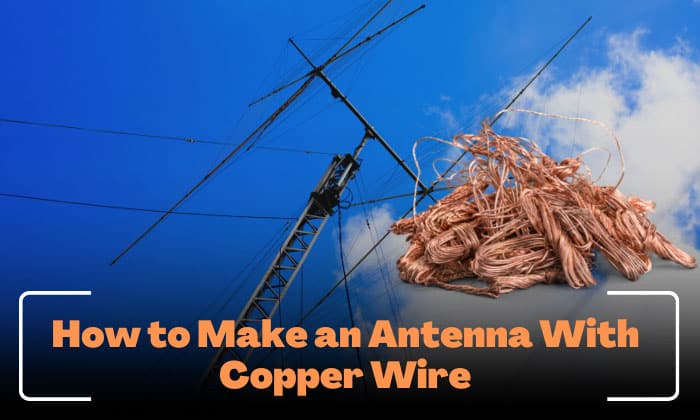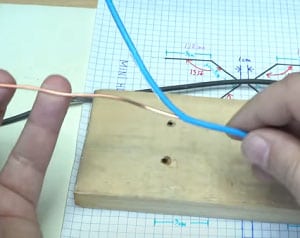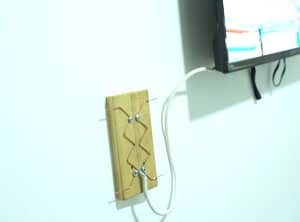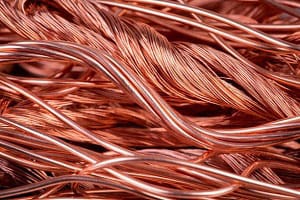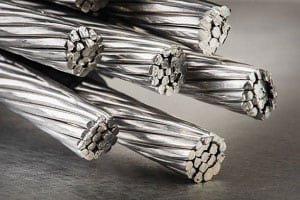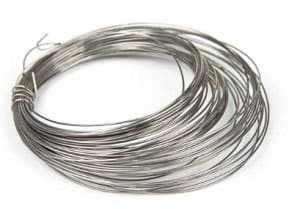If you’re searching for a simple method to enhance your TV or radio reception, you might want to make a radio antenna with copper wire as a solution! Creating a homemade copper wire TV antenna, as well as one for radios, is an economical approach that can significantly improve the signal quality around you.
So, if you’re annoyed by blurry displays or static noises, this guide will explain how to make an antenna with copper wire in simple yet effective steps. Therefore, grab your tools, and let’s start!
Contents
- Step-by-Step to Make an Antenna With Copper Wire
- What to Prepare
- Step 1: Cut the copper wire to the length you need
- Step 2: Remove the insulation
- Step 3: Attach the wood screws to the small block of wood
- Step 4: Wrap the wires
- Step 5: Secure the transformer to the wood screws
- Step 6: Connect the RG-6 coaxial cable
- Step 7: Hang the antenna
- Step 8: Tune in to a channel
- Best Materials for Antennas
- Conclusion
Step-by-Step to Make an Antenna With Copper Wire
What to Prepare
- Copper wire
- Wood screws
- Small block of wood
- Transformer with spade connectors
- Wire cutter
- RG-6 cable
- Rope
Step 1: Cut the copper wire to the length you need
The overall length to construct a DIY HD antenna copper wire is generally up to 150 centimeters for most radios and TVs. You may also calculate its length by dividing 143 by the frequency you tune into in megahertz.
Of course, you’d want to divide this number (or the 150 cm default) in two to get the length of each antenna leg, though note that the formula we gave will provide a result in meters and not centimeters.
To cut the wire, use a pair of wire cutters or scissors.
Step 2: Remove the insulation
With your wire cutter, take out the insulation. Just be careful not to damage or break the wire in the process.
Then, ensure that the wire is clean and free of any debris or oxidation that may affect its ability to conduct signals.
Step 3: Attach the wood screws to the small block of wood
You may use any tool to do this, like a screwdriver. Just make sure the screws sit securely.
Step 4: Wrap the wires
Take one end of each wire you prepared and wrap it securely and tightly around each screw to make a wire antenna.
Step 5: Secure the transformer to the wood screws
For the antenna to work, you need to connect a transformer to it by securing the spade connectors of the transformer to the screws.
Step 6: Connect the RG-6 coaxial cable
Connect one end of the cable to the spade connectors on the transformer and the other to your radio’s antenna terminal. The RG-6 cable can transfer satellite signals well and reduce interference.
Step 7: Hang the antenna
Tie a separate piece of rope onto each wire loop at the top of the antenna. Then, use the ropes to suspend the antenna and keep your radio area clutter-free.
Make sure you do this securely and ensure that the antenna cannot fall.
Step 8: Tune in to a channel
After making your own antenna and connecting it, turn the stereo on and tune into a channel or station. To get more channels, adjust the antenna until you achieve the best possible signal clarity. Placing the device outside is better than leaving it indoors, for example.
That’s it! You just learned how to create an effective copper wire antenna on your own.
Best Materials for Antennas
Antenna materials are selected based on various factors, such as their frequency range, size, shape, radiation pattern, and intended use. You will find antennas made of the following materials:
1. Copper
Copper is used to make a powerful antenna because of its exceptional electrical conductivity and resistance to corrosion. Its common copper antenna types include dipoles or loops.
Additionally, this is an efficient transmitter and receiver of radio signals with minimal loss, and it is easily accessible around you, making it inexpensive and great for this DIY project.
2. Aluminum
Aluminum has good electrical conductivity and is less expensive and heavy than copper.
Due to its durable properties and low weight, it is suitable for outdoor installations. Although not as conductive as copper, it has enough conductivity to perform as an antenna.
3. Stainless steel
Stainless steel is among the best materials for building your own antenna. It is recognized for good strength, durability, and ability to resist corrosion, which makes it an ideal material for outdoor antennas that are exposed to environmental factors.
However, this material is more expensive than aluminum.
So, what is the best among the three? It’s copper. Copper’s high conductivity makes it ideal for transmitting current and heat in various applications, including aerials and cables, with better efficiency than aluminum and steel.
Material selection also depends on cost, weight, and durability. Stainless steel may be suitable for portable antennas due to its low rigidity, but not for base antennas due to its low conductivity.
Conclusion
Building a homemade antenna for radio or a good homemade TV antenna with a copper wire can be a simple and cheap solution, but it may not always be the best option. We suggest that you consider purchasing a ready-made antenna to ensure reliable signal reception and prevent complications.
So, even though you already know how to make an antenna with copper wire, test it out first and see how it works before sticking with this device in the long term.

Hello! I am Hart, the content writer and editor here at G0HWC. I used to be in the same local radio club with Howe, and he convinced me to join him in spreading my love for the radio with others. With a background in radio studies, I spend every day crafting accurate, easy to read content on various topics related to owning and using radios. I hope that my content can help you confidently venture in your radio journey!

